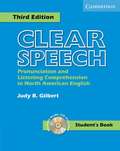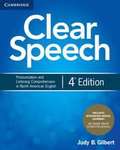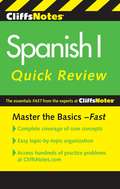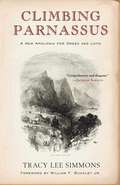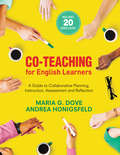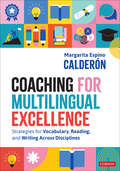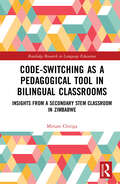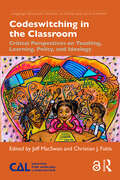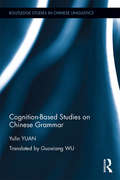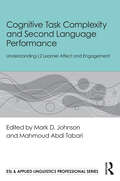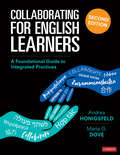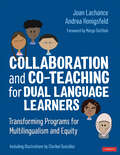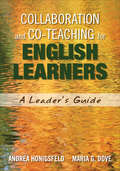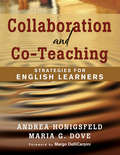- Table View
- List View
Classroom Instruction That Works With English Language Learners
by Jane Hill Kathleen FlynnAs more and more English language learners (ELLs) are included in mainstream classrooms, what can we do to ensure that they understand academic content and develop their English language skills? To answer this question, authors Jane Hill and Kathleen Flynn have examined decades of research, interviewed mainstream teachers with ELLs in their classrooms, and reviewed the classroom recommendations from Marzano, Pickering, and Pollock's seminal Classroom Instruction That Works (2001) through an ELL lens. The result is Classroom Instruction That Works with English Language Learners—-a comprehensive guide to helping elementary school students at all levels of English language acquisition succeed. <p><p> The strategies discussed in the book include homework and practice, summarization and note taking, and use of nonlinguistic representations, among many others. For each strategy, the authors provide a summary of the research, detailed examples of how to modify the strategy for use with ELLs in mainstream classrooms, and teacher accounts of implementation. Because ELLs face cultural hurdles as well as linguistic ones, this book also shows teachers how to glean insight into students' backgrounds and address the cultural biases inherent in many classroom practices. <p> Accommodating English language learners is one of the greatest challenges educators face today. Just as different levels of fluency require different approaches, so too do different backgrounds and languages. This practical, research-based book gives elementary school teachers the guidance they need to help ELLs of all nationalities thrive alongside their English-dominant peers.
Classroom Interactions as Cross-Cultural Encounters: Native Speakers in EFL Lessons (ESL & Applied Linguistics Professional Series)
by Angel M. Lin Jasmine C. LukClassroom Interactions as Cross-Cultural Encounters is about native English speakers teaching English as a global language in non-English speaking countries. Through analysis of naturally occurring dialogic encounters, the authors examine the multifaceted ways in which teachers and students utilize diverse communicative resources to construct, display, and negotiate their identities as teachers, learners, and language users, with different pedagogic, institutional, social, and political implications. A range of issues in applied linguistics is addressed, including linguistic imperialism, post-colonial theories, micropolitics of classroom interaction, language and identity, and bilingual classroom practices. Intended to help TESOL professionals of different cultural backgrounds, working in different sociocultural contexts, to critically understand how non-assimilationist, dialogic intercultultural communication with students can be achieved and built on for mutual cultural and linguistic enrichment and empowerment, this book:*emphasizes the sociocultural meanings and micropolitics of classroom interactions that reveal the complex realities of power and identity negotiations in cross-cultural interactions in ELT (English Language Teaching) classroom contexts;*revisits and reconstitutes the notion of native-speakerness and repositions the roles of native and non-native English teachers in the TESOL profession in the contexts of decolonization and globalization; *highlights the need to mobilize intercultural communicative resources for global communication;*addresses two major concerns of EFL (English as a Foreign Language) classroom researchers and teachers: student resistance and learning motivation; and*examines and analyzes the changing ideologies (both explicit and implicit) of teachers and students about English learning in the context of a post-colonial society, and how these ideologies are being enacted, reproduced, but also sometimes contested in EFL classroom interactions. Each chapter includes Questions for Reflection and Discussion to promote critical thinking and understanding of the issues discussed. Tuning-In discussion questions are provided in the three chapters on classroom data analysis to activate readers interpretive schemas before they examine the actual classroom episodes. The data are from an ethnographic study in post-colonial Hong Kong secondary schools involving four native English-speaker teachers and two bilingual Cantonese-English speaking teachers engaged in intercultural classroom dialogues with their Cantonese Hong Kong students. The rich, naturally occurring classroom data and in-depth analyses provide useful pedagogical materials for courses in EFL teacher education programs on classroom discourse analysis from sociocultural perspectives.
Clear English Pronunciation: A Practical Guide
by Dick SmakmanClear English Pronunciation provides students with the tools to effectively communicate in English without centring solely on native-speaker pronunciation models. The focus of the book is on individual pronunciation targets rather than a one-size-fits-all approach. Divided into four sections, each featuring detailed articulatory explanations, sample sentences, and recordings to help learners improve their pronunciation, this book: introduces the phenomenon of pronunciation as part of a broader communicative realm; explains and demonstrates the melody and rhythm of understandable and natural English pronunciation; supports students in identifying and practicing their own pronunciation issues. Supported by an interactive companion website which features recordings and expanded explanations of key topics, Clear English Pronunciation is an essential textbook for international learners of English who want to improve their pronunciation skills in diverse social settings. https://www.universiteitleiden.nl/clearenglishpronunciation
Clear Speech: Pronunciation and Listening Comprehension in North American English (3rd Edition)
by Judy B. GilbertThis book is designed to help students make the most efficient use of their time as they learn to pronounce English better.
Clear Speech: Pronunciation and Listening Comprehension in North American English (4th Edition)
by Judy B. GilbertThe Clear Speech, Fourth Edition, Student's Book provides easy-to-follow presentations, helpful rules, and extensive practice in pronunciation. This revised edition offers new and updated content, additional visual support, and is now in full color.
CliffsNotes Spanish I Quick Review, 2nd Edition
by Ken Stewart Jill RodriguezSpelling and Pronunciation Nouns and Articles Replacing Nouns with Pronouns Infinitive and Regular Verb Use Basic Sentence Structure Irregular Verbs in the Present Tense Asking and Answering Questions Adjectives Adverbs and Comparisons Direct and Indirect Object Pronouns The Present Tense The Imperfect Tense Narration in the Past Prepositions Reflexive, Prepositional, and Demonstrative Pronouns Commands Negatives Review Questions Resource Center Glossary Thematic Vocabulary Verb Charts Idiomatic Expressions Why CliffsNotes? Go with the name you know and trust Get the information you need-fast! CliffsNotes Quick Review guides give you a clear, concise, easy-to-use review of the basics. Introducing each topic, defining key terms, and carefully walking you through sample problems, this guide helps you grasp and understand the important concepts needed to succeed. The essentials FAST from the experts at CliffsNotes Master the Basics - Fast Complete coverage of core concepts Easy topic-by-topic organization Access hundreds of practice problems at CliffsNotes.com
Climbing Parnassus: A New Apologia for Greek and Latin
by Tracy Lee SimmonsIn Climbing Parnassus, winner of the 2005 Paideia Prize, Tracy Lee Simmons presents a defense and vindication of the formative power of Greek and Latin. He also shows how these languages have played a crucial role in the development of authentic Humanism, the foundation of the West's cultural order and America's understanding of itself as a union of citizens. Simmons's persuasive witness to the unique, now all-but-forgotten advantages of study in and of the classical languages constitutes a bracing reminder of the genuine aims of a truly liberal education.
Co-Planning: Five Essential Practices to Integrate Curriculum and Instruction for English Learners
by Maria G. Dove Andrea HonigsfeldPool your collective wisdom in support of your English learners! English Learners (ELs) and multilingual learners (MLs) have double the work of their English-speaking peers as they are required to master language and content simultaneously. To support this dynamic academic and language development process, all teachers need to have an understanding of language acquisition and EL/ML-specific methodologies along with offering social-emotional support to ELs/MLs and work in tandem with each other. Bestselling authors Andrea Honigsfeld and Maria G. Dove have returned with this new resource that complements and expands on their previous titles on co-teaching and collaboration by addressing collaborative planning in greater depth. Co-planning is positioned as the first step toward integrative language and content instruction as regular and purposeful collaboration ensures that Els/MLs have access to core content. Key features include: • Practical, step-by-step guidance to starting and sustaining collaborative planning for integrated language, literacy, and social-emotional development • An array of checklists, templates, and protocols for immediate implementation • Snapshots from the Field provide real-life examples of co-planning in action • Beautiful full-color design with original sketch notes to bring concepts to life • QR codes that link to author interviews elaborating on key ideas This substantial guide will assist novice and seasoned educators alike in their move away from isolated practices and help them engage in collaborative planning and professional dialogue about asset-based, best practices for ELs/MLs.
Co-Planning: Five Essential Practices to Integrate Curriculum and Instruction for English Learners
by Maria G. Dove Andrea HonigsfeldPool your collective wisdom in support of your English learners! English Learners (ELs) and multilingual learners (MLs) have double the work of their English-speaking peers as they are required to master language and content simultaneously. To support this dynamic academic and language development process, all teachers need to have an understanding of language acquisition and EL/ML-specific methodologies along with offering social-emotional support to ELs/MLs and work in tandem with each other. Bestselling authors Andrea Honigsfeld and Maria G. Dove have returned with this new resource that complements and expands on their previous titles on co-teaching and collaboration by addressing collaborative planning in greater depth. Co-planning is positioned as the first step toward integrative language and content instruction as regular and purposeful collaboration ensures that Els/MLs have access to core content. Key features include: • Practical, step-by-step guidance to starting and sustaining collaborative planning for integrated language, literacy, and social-emotional development • An array of checklists, templates, and protocols for immediate implementation • Snapshots from the Field provide real-life examples of co-planning in action • Beautiful full-color design with original sketch notes to bring concepts to life • QR codes that link to author interviews elaborating on key ideas This substantial guide will assist novice and seasoned educators alike in their move away from isolated practices and help them engage in collaborative planning and professional dialogue about asset-based, best practices for ELs/MLs.
Co-Teaching for English Learners: A Guide to Collaborative Planning, Instruction, Assessment, and Reflection
by Maria G. Dove Andrea Honigsfeld"Dove and Honigsfeld′s new book arrives at the perfect time as an increasing number of schools move to a collaborative instructional model and are searching for guidance. The authors not only tell us how to effectively collaborate and co-teach to benefit English learners, they actually show us what each component of the collaborative instructional cycle looks and feels like, complemented by innovative video and web content." —DIANE STAEHR FENNER, Coauthor of Unlocking ELs’ Potential and President of SupportEd Because teacher collaboration isn’t an option, it’s a MUST! The proof is borne out by any assessment: our non-native speakers learn faster and achieve more when general ed teachers and EL specialists co-plan and co-deliver instruction in the very same classroom. That’s why you’ll want to put Co-Teaching for English Learners at the top of your reading list. Step by step, EL authorities Maria Dove and Andrea Honigsfeld walk you through the entire collaborative instruction cycle, along with seven potential classroom configurations from which to choose. Whether you’re new to co-teaching or just see room for improvement in your practice, this practical handbook delivers every technique and tool you need to make the most of your collaboration, including video footage of co-teaching in action. Inside you’ll find: • In-depth profiles of the seven models, with detailed descriptions and analyses • A review of advantages and challenges of each model’s implementation • Clear explanations of each teacher’s role along with self-assessment tools • Tried-and-true strategies for the entire instructional cycle: co-planning, co-instruction, co-assessment, and reflection • Real-life accounts from co-teaching veterans Long gone are the days when our ELs are taught in isolation—and rightfully so. Read Co-Teaching for English Learners, implement its strategies, and soon enough you, too, can set up a learning environment in which all students thrive.
Co-Teaching for English Learners: A Guide to Collaborative Planning, Instruction, Assessment, and Reflection
by Maria G. Dove Andrea Honigsfeld"Dove and Honigsfeld′s new book arrives at the perfect time as an increasing number of schools move to a collaborative instructional model and are searching for guidance. The authors not only tell us how to effectively collaborate and co-teach to benefit English learners, they actually show us what each component of the collaborative instructional cycle looks and feels like, complemented by innovative video and web content." —DIANE STAEHR FENNER, Coauthor of Unlocking ELs’ Potential and President of SupportEd Because teacher collaboration isn’t an option, it’s a MUST! The proof is borne out by any assessment: our non-native speakers learn faster and achieve more when general ed teachers and EL specialists co-plan and co-deliver instruction in the very same classroom. That’s why you’ll want to put Co-Teaching for English Learners at the top of your reading list. Step by step, EL authorities Maria Dove and Andrea Honigsfeld walk you through the entire collaborative instruction cycle, along with seven potential classroom configurations from which to choose. Whether you’re new to co-teaching or just see room for improvement in your practice, this practical handbook delivers every technique and tool you need to make the most of your collaboration, including video footage of co-teaching in action. Inside you’ll find: • In-depth profiles of the seven models, with detailed descriptions and analyses • A review of advantages and challenges of each model’s implementation • Clear explanations of each teacher’s role along with self-assessment tools • Tried-and-true strategies for the entire instructional cycle: co-planning, co-instruction, co-assessment, and reflection • Real-life accounts from co-teaching veterans Long gone are the days when our ELs are taught in isolation—and rightfully so. Read Co-Teaching for English Learners, implement its strategies, and soon enough you, too, can set up a learning environment in which all students thrive.
Coaching for Multilingual Excellence: Strategies for Vocabulary, Reading, and Writing Across Disciplines
by Margarita Espino CalderonBe the instructional coach multilingual students and their teachers need. As the population of multilingual learners (MLs) in K–12 schools continues to grow, instructional coaches must support content teachers to recognize these students’ assets and address their linguistic, cultural, academic, and social-emotional needs. Leveraging her decades of facilitating and coaching experience in the fields of language, literacy, and professional learning, Margarita Calderón meets this urgent need with practical, evidence-based strategies to leverage the power of coaching in support of ML excellence. Through the individual chapters dedicated to academic language, reading, and writing instruction and strategies to promote student discourse and social-emotional learning embedded throughout, this book will give coaches what they need to guide all teachers toward ML excellence. Additional features include A step-by-step framework designed to help coaches promote teacher efficacy with MLs regardless of program setting or instructional approach Clear guidance for how to structure coaching sessions with teachers, driven by research-based approaches and observation and feedback protocols for accelerating student comprehension Myth-busting facts about the do’s and don′ts of effective coaching for ML success Spotlights on the experiences of veteran coaches focusing on successes, challenges, and tips to remain resilient Individual and group reflection questions and tools at the close of each chapter Offering solutions to the challenges faced by MLs that content area teachers must be prepared to address, this book is a powerful tool coaches can use to move multilingual instruction beyond compliance to excellence.
Coaching for Multilingual Excellence: Strategies for Vocabulary, Reading, and Writing Across Disciplines
by Margarita Espino CalderonBe the instructional coach multilingual students and their teachers need. As the population of multilingual learners (MLs) in K–12 schools continues to grow, instructional coaches must support content teachers to recognize these students’ assets and address their linguistic, cultural, academic, and social-emotional needs. Leveraging her decades of facilitating and coaching experience in the fields of language, literacy, and professional learning, Margarita Calderón meets this urgent need with practical, evidence-based strategies to leverage the power of coaching in support of ML excellence. Through the individual chapters dedicated to academic language, reading, and writing instruction and strategies to promote student discourse and social-emotional learning embedded throughout, this book will give coaches what they need to guide all teachers toward ML excellence. Additional features include A step-by-step framework designed to help coaches promote teacher efficacy with MLs regardless of program setting or instructional approach Clear guidance for how to structure coaching sessions with teachers, driven by research-based approaches and observation and feedback protocols for accelerating student comprehension Myth-busting facts about the do’s and don′ts of effective coaching for ML success Spotlights on the experiences of veteran coaches focusing on successes, challenges, and tips to remain resilient Individual and group reflection questions and tools at the close of each chapter Offering solutions to the challenges faced by MLs that content area teachers must be prepared to address, this book is a powerful tool coaches can use to move multilingual instruction beyond compliance to excellence.
Code-Switching as a Pedagogical Tool in Bilingual Classrooms: Insights from a Secondary STEM Classroom in Zimbabwe (Routledge Research in Language Education)
by Miriam ChitigaPresenting a mixed methods study conducted in a bilingual mathematics classroom in Zimbabwe, this text reveals the semantic pedagogical functions and linguistic forms of code-switching during STEM instruction. Code-Switching as a Pedagogical Tool in Bilingual Classrooms offers a detailed analysis of code-switching in the context of educational linguistics, and reveals ten major pedagogical techniques which illustrate how teachers use code-switches to engage students and provide guidance, clarification, discipline, and recaps during individual and whole-class interactions. Chapters highlight that code-switching can be used in a targeted manner to harness the cognitive potential of bilingual speakers and enhance instruction. Ultimately, the text identifies implications for teacher education, language policy, and educational leadership more broadly, and demonstrates intersections with key areas including functional, critical, and cultural literacy. This text will benefit researchers, academics, and educators with an interest in bilingualism, applied linguistics, and secondary education more broadly. Those specifically interested in multicultural education, sociolinguistics and educational policy will also benefit from this book.
Codeswitching in the Classroom: Critical Perspectives on Teaching, Learning, Policy, and Ideology (Language Education Tensions in Global and Local Contexts)
by Jeff MacSwan Christian Jan FaltisBringing together sociolinguistic, linguistic, and educational perspectives, this cutting‐edge overview of codeswitching examines language mixing in teaching and learning in bilingual classrooms. As interest in pedagogical applications of bilingual language mixing increases, so too does a need for a thorough discussion of the topic. This volume serves that need by providing an original and wide-ranging discussion of theoretical, pedagogical, and policy‐related issues and obstacles in classroom settings—the pedagogical consequences of codeswitching for teaching and learning of language and content in one‐way and two‐way bilingual classrooms. Part I provides an introduction to (socio)linguistic and pedagogical contributions to scholarship in the field, both historical and contemporary. Part II focuses on codeswitching in teaching and learning, and addresses a range of pedagogical challenges to language mixing in a variety of contexts, such as literacy and mathematics instruction. Part III looks at language ideology and language policy to explore how students navigate educational spaces and negotiate their identities in the face of competing language ideologies and assumptions. This volume breaks new ground and serves as an important contribution on codeswitching for scholars, researchers, and teacher educators of language education, multilingualism, and applied linguistics.
Cognition-Based Studies on Chinese Grammar (Routledge Studies in Chinese Linguistics)
by Yulin YuanIntroducing the English translations of 8 selected research articles originally written in Chinese by Professor Yuan Yulin, Cognition-based Studies on Chinese Grammar is an essential reading for researchers in Chinese syntax. Yuan Yulin is one of the very first Chinese scholars who introduced cognitive sciences into the study of Chinese language some twenty years ago, and his work is well-known and highly regarded in China for its originality and theoretical contribution. The collection covers the core of his engagement with Chinese language studies, ranging from lexical exploration to grammatical discussion. Cognition-based Studies on Chinese Grammar is designed for students or researchers who specialize in the Chinese language, contemporary Chinese grammar and cognitive linguistics. It can also serve as a reference book for instructors or teachers engaged in Chinese language pedagogy or in teaching Chinese as a second or foreign language.
Cognitive Processing Skills in English (Effective Interpreting)
by Carol J. PatrieInterpret more effectively and energetically. That is the goal of top interpreter educator Carol Patrie, who writes: "Interpreters must be able to quickly make sense out of what they see and hear, decide what the message means and how to transfer that message into another language with split-second accuracy." The stronger one's English skills, the better one interprets. Effective interpreters shift more easily between English and ASL, enjoy translating, consecutive interpreting, and simultaneous interpreting more, and have more satisfied clients. Cognitive Processing Skills in English is full of challenging exercises with videotaped source materials to improve flexibility and agility with English, the kind of linguistic quickness that is essential to the interpreting process. Give yourself a comprehensive, powerful learning tool with helpful theoretical Introductions for each topic, Study Questions, and a structured Five-Step Follow-up.
Cognitive Task Complexity and Second Language Performance: Understanding L2 Learner Affect and Engagement (ESL & Applied Linguistics Professional Series)
by Mark D. Johnson Mahmoud Abdi TabariCognitive Task Complexity and Second Language Performance provides an overview of research focusing on the effects of cognitive task complexity (CTC) on second language (L2) performance. The edited volume brings together renowned scholars in the field who present data-driven insights into the intricate relationships between CTC and L2 performance, drawing on a combination of empirical studies and theoretical analyses.Each section summarizes the intersection of task complexity frameworks and models of second language production; synthesizes critical issues and research findings; and moves beyond the routine discussion of task complexity features and models of speaking, extending the discussion to the interface of task complexity features and (a) learner engagement, (b) virtual interaction, and (c) corpus linguistics. It also delves into the interface of CTC and technology, exploring how digital tools and resources can enhance task complexity and ultimately impact L2 performance. Overall, this edited volume not only consolidates the existing research on CTC and L2 performance but also highlights areas that require further investigation.In charting a course for future research and pedagogy, the book is a valuable resource for students, scholars, researchers, and practitioners seeking to deepen their understanding of CTC and its impact on second language acquisition.
Collaborating for English Learners: A Foundational Guide to Integrated Practices
by Maria G. Dove Andrea HonigsfeldLooking for a silver bullet to accelerate EL achievement? There is none. But this, we promise: when EL specialists and general ed teachers pool their expertise, your ELs’ language development and content mastery will improve exponentially. Just ask the tens of thousands of Collaboration and Co-Teaching users and now, a new generation of educators, thanks to this all-new second edition: Collaborating for English Learners. Why this new edition? Because more than a decade of implementation has generated for Andrea Honigsfeld and Maria Dove new insight into what exemplary teacher collaboration looks like, which essential frameworks must be established, and how integrated approaches to ELD services benefit all stakeholders. Essentially a roadmap to the many different ways we can all work together, this second edition of Collaborating for English Learners features: All-new examples, case studies, illustrative video, and policy updates In-depth coverage of the full range of strategies and configurations for determining the best model to adopt Templates, planning guides, and other practical tools to put collaboration into practice Guidelines, self-assessments, and questionnaires for evaluating the strategies’ effectiveness By this time, the big benefits of teacher collaboration are well documented. Where teachers and schools struggle still is determining the best way to do so, especially when working with our ELs. That’s where Andrea Honigsfeld, Maria Dove, and their second edition of Collaborating for English Learners will prove absolutely indispensable. After all, there are no two better authorities.
Collaborating for English Learners: A Foundational Guide to Integrated Practices
by Maria G. Dove Andrea HonigsfeldLooking for a silver bullet to accelerate EL achievement? There is none. But this, we promise: when EL specialists and general ed teachers pool their expertise, your ELs’ language development and content mastery will improve exponentially. Just ask the tens of thousands of Collaboration and Co-Teaching users and now, a new generation of educators, thanks to this all-new second edition: Collaborating for English Learners. Why this new edition? Because more than a decade of implementation has generated for Andrea Honigsfeld and Maria Dove new insight into what exemplary teacher collaboration looks like, which essential frameworks must be established, and how integrated approaches to ELD services benefit all stakeholders. Essentially a roadmap to the many different ways we can all work together, this second edition of Collaborating for English Learners features: All-new examples, case studies, illustrative video, and policy updates In-depth coverage of the full range of strategies and configurations for determining the best model to adopt Templates, planning guides, and other practical tools to put collaboration into practice Guidelines, self-assessments, and questionnaires for evaluating the strategies’ effectiveness By this time, the big benefits of teacher collaboration are well documented. Where teachers and schools struggle still is determining the best way to do so, especially when working with our ELs. That’s where Andrea Honigsfeld, Maria Dove, and their second edition of Collaborating for English Learners will prove absolutely indispensable. After all, there are no two better authorities.
Collaboration and Co-Teaching for Dual Language Learners: Transforming Programs for Multilingualism and Equity
by Andrea Honigsfeld Joan R. LachanceTeaching dual-language learners? You’re not alone! When implemented with commitment to collaboration, dual language programs work—and two teachers are better than one. Leveraging the power of teacher collaboration is the key to leading all your students to multilingual identity development and language, literacy, and academic success. This practical book adapts a widely used, evidence-based collaboration and co-teaching framework specifically for educators in dual-language contexts. Features include: Special consideration to social justice and promoting critical consciousness Viable options for schools, districts, and state education agencies to effectively support and expand dual-language education Seven proven co-teaching models, newly applied to elementary and secondary dual-language environments Templates and tools for collaborative curriculum alignment and implementation of dual-language instruction Authentic examples of success from collaborative dual-language teams around the US and beyond More and more schools are implementing dual language programs to serve multilingual learners. This first-of-its-kind innovative resource helps collaborating educators work together to design, deliver, and assess engaging instruction for multilingualism and multiliteracies.
Collaboration and Co-Teaching for Dual Language Learners: Transforming Programs for Multilingualism and Equity
by Andrea Honigsfeld Joan R. LachanceTeaching dual-language learners? You’re not alone! When implemented with commitment to collaboration, dual language programs work—and two teachers are better than one. Leveraging the power of teacher collaboration is the key to leading all your students to multilingual identity development and language, literacy, and academic success. This practical book adapts a widely used, evidence-based collaboration and co-teaching framework specifically for educators in dual-language contexts. Features include: Special consideration to social justice and promoting critical consciousness Viable options for schools, districts, and state education agencies to effectively support and expand dual-language education Seven proven co-teaching models, newly applied to elementary and secondary dual-language environments Templates and tools for collaborative curriculum alignment and implementation of dual-language instruction Authentic examples of success from collaborative dual-language teams around the US and beyond More and more schools are implementing dual language programs to serve multilingual learners. This first-of-its-kind innovative resource helps collaborating educators work together to design, deliver, and assess engaging instruction for multilingualism and multiliteracies.
Collaboration and Co-Teaching for English Learners: A Leader's Guide
by Andrea M. Honigsfeld Maria G. DoveYour English Language Learners are counting on you to collaborate effectively. The Common Core State Standards have increased the pressure on English Language Learners. And with the EL population increasing every day, schools need proven systems for ensuring that the students of the future are able to thrive. In practice, this is a challenge for educational leaders. The most promising solution is the collaborative approach pioneered by this book’s authors—America’s leading authorities on collaboration and co-teaching for EL achievement. Honigsfeld and Dove’s resources for collaboration and co-teaching include Templates for creating EL profiles that will enable you to address their unique needs Prompts for Professional Learning activities (for teams or individuals) and further reading The latest research findings on best instructional practices that benefit ELs This is your concise, comprehensive guide to creating a powerful collaborative program to benefit your ELs. Start implementing it today and watch the outcomes improve.
Collaboration and Co-Teaching for English Learners: A Leader's Guide
by Andrea M. Honigsfeld Maria G. DoveYour English Language Learners are counting on you to collaborate effectively. The Common Core State Standards have increased the pressure on English Language Learners. And with the EL population increasing every day, schools need proven systems for ensuring that the students of the future are able to thrive. In practice, this is a challenge for educational leaders. The most promising solution is the collaborative approach pioneered by this book’s authors—America’s leading authorities on collaboration and co-teaching for EL achievement. Honigsfeld and Dove’s resources for collaboration and co-teaching include Templates for creating EL profiles that will enable you to address their unique needs Prompts for Professional Learning activities (for teams or individuals) and further reading The latest research findings on best instructional practices that benefit ELs This is your concise, comprehensive guide to creating a powerful collaborative program to benefit your ELs. Start implementing it today and watch the outcomes improve.
Collaboration and Co-Teaching: Strategies for English Learners
by Andrea M. Honigsfeld Maria G. DoveHelp ELLs achieve success with an integrated, collaborative program! This resource provides a practical guide to collaboration and co-teaching between general education teachers and ESL specialists to better serve the needs of ELLs. Offering classroom vignettes, step-by-step guidelines, ready-to-use resources, and in-depth case studies, the authors help educators: Understand the benefits and challenges of collaborative service delivery Teach content while helping students meet English language development goals Choose from a range of collaborative strategies and configurations, from informal planning and collaboration to a co-teaching partnership Use templates, planning guides, and other practical tools to put collaboration into practice



